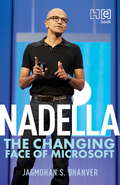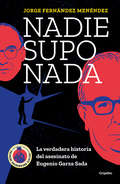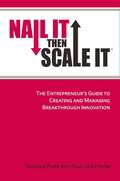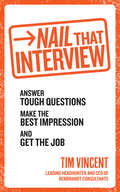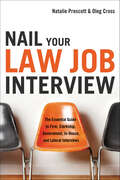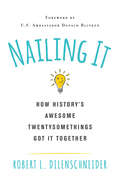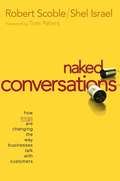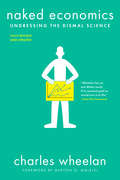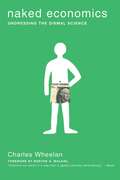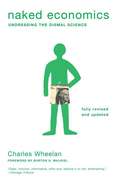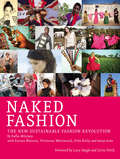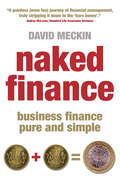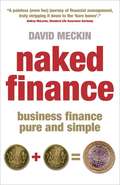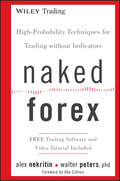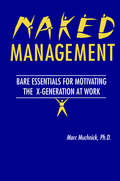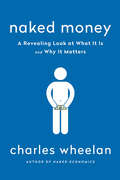- Table View
- List View
Nachhaltigkeitstransformationen erfolgreich initiieren und gestalten: Psychologische Perspektiven und Handlungsempfehlungen für Manager:innen (essentials)
by Paula Maria BögelDie aktuellen Geschehnisse zeigen, dass eine rasche und entschiedene Wende hin zu einer nachhaltigen Entwicklung unumgänglich ist, wenn wir uns und unseren Planeten retten wollen. Gerade Unternehmen können hier einen großen Beitrag leisten. Trotzdem kommen wir oft nicht ins Handeln oder es fehlen die Mitstreiter:innen im Unternehmen. Das essential stellt die wichtigsten Strategien für eine erfolgreiche Veränderung hin zu mehr Nachhaltigkeit vor und zeigt, wie Mitstreiter:innen für diese Transformation gewonnen werden. Es geht konkret der Frage nach, was wir aus der Psychologie für die Nachhaltigkeitstransformation lernen können. So werden psychologische Theorien verständlich vorgestellt, inspirierende Fallbeispiele gezeigt und konkrete Impulse für die Umsetzung im eigenen Unternehmen (und privatem Umfeld) gegeben.
Nachhaltigkeitswissenschaften
by Harald Heinrichs and Gerd MichelsenForscher und Dozenten der ersten deutschen Fakultät für Nachhaltigkeitswissenschaften an der Universität Lüneburg haben das Standardwerk zum Thema geschrieben. Sie schildern zunächst die naturwissenschaftlich-technischen Grundlagen, um anschließend die Perspektive der Akteure und integrierende Ansätze darzustellen. Zuletzt werden beispielhaft Problem- und Handlungsfelder wie Biodiversität und globale Gerechtigkeit aufgezeigt. Mit Infokästen, illustrativen Fallbeispielen sowie Hinweisen zu weiterführender Literatur und relevanten Institutionen.
Nachhaltigkeitsökonomik: Eine Einführung
by Peter BartelmusDas Buch führt ein in das zunehmend wichtige Feld der ökonomischen Nachhaltigkeit und verbindet verschiedene Disziplinen: Umweltwissenschaft, Umweltökonomie und Wirtschaftsökonomie sowie Wachstumstheorien. Da Nachhaltigkeit verschiedene Lesarten hat, verfolgt der Autor zwei Intentionen: eine Systematik in Maßnahmen, Modelle und Management der Nachhaltigkeit zu bringen sowie den Zugang zu diesem komplexen, interdisziplinären Thema zu erleichtern. Das Buch schließt eine Lücke zwischen den Disziplinen und wird damit zum wichtigsten Ratgeber derzeit, um die aktuellen Konzepte zu verstehen und anzuwenden. Als Lehrbuch konzipiert, ist es auch für gesellschaftlich Interessierte geschrieben. Zahlreiche, eigen erstellte Illustrationen visualisieren die Ausführungen.
Nachtexpress: Wertschöpfung und Wettbewerbsvorteil durch die Zustellung zeitkritischer Sendungen vor Arbeitsbeginn (essentials)
by Heike SteinmetzAfter Sales Service und Ersatzteillogistik gewinnen zunehmend an Bedeutung. Ein bewährtes – aber trotzdem weitestgehend unbekanntes – Konzept ist die Zustellung zeitkritischer Teile im Nachtexpress. Das Besondere: Sendungen, die bis zum frühen Abend bestellt und abgeholt werden, erreichen ihren Empfänger bereits am nächsten Werktag vor Arbeitsbeginn. Mit diesem Service profitieren Hersteller, Händler und Werkstätten auf vielfältige Weise – angefangen von schlankeren Strukturen, Kosteneinsparungen bis hin zum effizienteren Einsatz der Mitarbeiter. Unternehmen, die ihr logistisches Konzept auf Nachtexpress ausrichten, können ihre Lagerstruktur optimieren und die Kapitalbindungskosten senken, da weniger Ersatzteile bevorratet werden müssen – bei gleichzeitiger Steigerung der Kundenzufriedenheit und -loyalität.
Nadella: The Changing Face of Microsoft
by Jagmohan S. BhanverA concise, insightful account of Satya Nadella the man and the professional, and what his appointment as the third CEO of Microsoft means for the future of the tech industry The appointment of Satya Nadella, the man from Hyderabad, as CEO of Microsoft Corp. has sent waves of curiosity, speculation and expectation through the tech world at home and abroad. What drives the man chosen to lead tech giant Microsoft into the future? What does Nadella?s appointment in particular herald for Microsoft and, indeed, for the tech industry as a whole? Nadella: The Changing Face of Microsoft brings together reportage, interviews and analysis to provide a comprehensive look at: ? Nadella?s years of growing up in Hyderabad ? his family, education and early influences; ? Microsoft?s recent history, with particular emphasis on the organization?s functioning and fortunes during the Ballmer era; ? Nadella?s constant engagement with innovation, his stellar achievements and rise within Microsoft?s ranks; ? Events within the organization that led to Nadella?s appointment, including an overview of the closest contenders for the post; ? The challenges and opportunities ahead for the Indian-born CEO of the fourth largest company in the world. Engaging and informative, this book will enlighten as much as it will inspire.'
Nadie supo nada
by Jorge Fernández MenéndezUn empresario legendario. Un asesinato que sigue impune. Cuarenta y seis años de dudas y una herida que sigue abierta en la sociedad mexicana. El 17 de septiembre de 1973 fue asesinado en Monterrey Eugenio Garza Sada, presidente del Consorcio Industrial Cervecería, corazón del llamado grupo Monterrey, sin duda el empresario más importante de su generación. Desde entonces hasta hoy no ha existido una versión oficial convincente sobre lo ocurrido aquel día. Por esta razón, entre otras, esa herida sigue abierta. La muerte de Garza Sada es uno de los capítulos más oscuros de nuestra historia, en el que se engarzan desde la aventura política de grupos armados radicales hasta especulaciones políticas del poder para restarle espacio a la iniciativa privada regiomontana, que había crecido con principios ideológicos diferentes de los del centro del país. Desde un año y medio antes del homicidio, la entonces Dirección Federal de Seguridad tenía conocimiento de quiénes integraban el comando que planeaba el secuestro de Garza Sada para obtener cinco millones de pesos y la liberación de un grupo de presos políticos. Los documentos que sustentan este libro confirman que el gobierno de Luis Echeverría sabía que se cometería el secuestro de Garza Sada. En esta edición, ampliada y actualizada, logra entenderse por qué el homicidio de Garza Sada sigue doliendo hoy día: por qué importa tento y qué pierde el país al mantener impunes crímenes así.
Nadine Vogel: Transforming the Marketplace, Workplace, and Workforce for People with Disabilities
by Michael Norris Lakshmi Ramarajan Hannah Riley BowlesIn 2019, Nadine Vogel, founder and CEO of Springboard Consulting, a firm that worked with Fortune 500 companies on issues related to disability and their workforce, faced the decision of the best path forward to grow her small company. Should she built more and better expertise to expand the topics she worked on with her current clientele? Or should she explore the possibility of moving into the new market of smaller businesses?
Nahrungsversorgungssysteme heute und morgen: Band 1 - Grundlagen, Strukturen und Funktionen
by Christian FischerWie lassen sich im Jahr 2050 etwa 10 Milliarden Menschen gesund ernähren und nachhaltig mit Nahrungsmittel versorgen? Dieses Buch behandelt in einfachen Worten aber mit der notwendigen inhaltlichen Tiefe einige der dringensten Probleme der Menschheit und diskutiert mögliche Lösungsansätze.Band 1 beschreibt die Grundlagen heutiger Nahrungsvorgungsketten und -systeme („Food Supply Chains and Systems“). Neben Fragen der Ressourcenverfügbarkeit werden alle Stufen der Nahrungsversorgungskette, das heißt die Landwirtschaft und Aquakultur, die Lebensmittelverarbeitung, der Lebensmittelhandel und der Verbrauch in Haushalten und außer Haus behandelt
Nail It Then Scale It: The Entrepreneur's Guide to Creating and Managing Breakthrough Innovation
by Nathan Furr Paul AhlstromNail It Then Scale It is the first lean startup book to help entrepreneurs through the process of launching a high-growth company. The book includes not just high-level principles, but a distilled, step by step guide of key actions successful entrepreneurs take to reduce risk and increase success. NISI answers key questions including: Why do most new businesses fail? What first steps do successful serial entrepreneurs take? What are the most common failure traps and how can I avoid them? Based on years of research and observation, Furr and Ahlstrom conclude that startups often fail by doing the "right things," but doing them out of order. In other words, human nature combined with entrepreneurial drive puts the entrepreneur on autopilot to become part of the 70% to 90% of ventures that fail. From Thomas Edison to Steve Jobs, the Nail It Then Scale It method is based on pattern recognition of the timeless principles and key practices used by successful entrepreneurs to repeatedly innovate. These processes and principles have now been distilled into a handbook to guide entrepreneurs step by step to victory. Stop following conventional wisdom and join the few entrepreneurs that consistently take their innovative ideas all the way to a successful product and company launch.
Nail That Interview: Answer tough questions, make the best impression, and get the job
by Tim VincentWith the jobs market more competitive than ever, how do you make sure you stand out from the crowd?In this game-changing new book, top recruitment consultant Tim Vincent reveals the secrets to successful interviews. Packed with insider insights, tips and advice, Nail That Interview covers everything you need to know to secure your dream job and build a rewarding career, including: · How to write a winning CV that reflects your skills, ambitions and values· How to prepare for interviews, from your outward appearance to your mental attitude· Tips on how to answer even the toughest interview questions· How to use the interview to launch a brilliant careerWith a step-by-step programme that puts you in charge of your future, Nail That Interview is the only careers advice you’ll ever need.
Nail Your Law Job Interview: The Essential Guide to Firm, Clerkship, Government, In-House, and Lateral Interviews
by Natalie Prescott Oleg CrossWinner, 2009 Career Book of the Year Award in ForeWord magazine (Gold Medal)Finalist, 2009 BOYTA Awards from Foreword Book ReviewsFinalist, 2010 Next Generation Indie Book Awards in career categoryNail Your Law Job Interview provides tips, examples, and substantive advice. This award-winning book is the only comprehensive interview guide for lawyers interviewing for any type of a legal job.Through real-life examples, interviews, and tips from hundreds of prominent legal professionals, judges, recruiters, and firm partners, this book reveals successful interview strategies, insider perspectives, bold moves, and unique challenges facing candidates in a difficult economy. Some topics covered in this book include:•Questions to ask and what not to ask•Dangerous answers and risky interviewing techniques•Body language, gap-fillers, and sample list of effective questions•What to wear, what to bring, and how to do your homework before the interview•Lunch interview etiquette•Dealing with inappropriate questions and arrogant interviewers•Tips for working with a headhunter and negotiating an offer•Interviewing after getting laid-off•Specific advice for government, clerkship, foreign, and in-house job applicants
Nailing It: How History's Awesome Twentysomethings Got It Together
by Robert L. DilenschneiderMozart * Mary Shelley * Honore Daumier * Ulysses S. Grant * Einstein * Othmar Ammann * Helen Keller When you&’re in your twenties, life can seem full of obstacles. Where&’s that glorious career you dreamed of? How can you make your way past student debt, economic uncertainty, and other challenges of adulting? Respected advisor Robert L. Dilenschneider takes you into the pages of history to show how 25 fascinating and diverse twenty-somethings found their way and created their legacies.Elizabeth Kenny * Branch Rickey * Jackie Robinson * Coco Chanel * Golda Meir *Roberto Marinho * Do you think Albert Einstein had his science career together by his mid-20s? Actually, he was a clerk in a patent office. Maya Angelou became a beloved, acclaimed poet and writer after a string of odd jobs during her young adulthood. Steve Jobs was at the top of his game by age 25. But his beginnings were marked by adoption, displacement, bullying, and many more challenges lay ahead. This absorbing book examines the trajectories of iconic figures to reveal the choices that enabled them to fulfill their potential. Rita Levi-Montalcini * Edith Piaf * I.M. Pei * Akio Morita * Maria Tallchief * Maya Angelou * For those who are coming of age now, and for those who care about them and their futures, these eye-opening time capsules provide inspiration, instruction, and encouragement. Audrey Hepburn * Rudolf Nureyev * Sally Ride* Christa McAuliffe * Steve Jobs * Jean-Michel Basquiat Foreword by U.S. Ambassador Donald Blinken
Naima Elbasi
by M. De Haan N. Van Halem Mevrouw S. OostveenZorgcategorie: Chronisch zieken Setting: ThuiszorgKorte inhoud: In dit werkboek staat het werk van verzorgende Naima Elbasi centraal. Een zelfbewuste jonge vrouw van Marokkaanse afkomst die met hart en ziel werkt in de zorg voor chronisch zieken in de thuiszorg. De thuiszorg is de grootste zorgsetting van de gezondheidszorg. Mensen ontvangen thuis diverse vormen van hulp: huishoudelijke zorg, begeleiding, verzorging en/of verpleging. Het accent in het werk van Naima ligt op de voorlichting en ver- zorging van chronisch zieke zorgvragers en van gezinnen met kinderen. De aard van de zorgrelatie kan zowel kort- als langdurend zijn.
Naked Conversations: How Blogs Are Changing the Way Businesses Talk with Customers
by Robert Scoble Shel IsraelScoble and coauthor Israel argue that every business can benefit from smart "naked" blogging, whether the company's a small town plumbing operation or a multinational fashion house. "If you ignore the blogosphere... you won't know what people are saying about you," they write. "You can't learn from them, and they won't come to see you as a sincere human who cares about your business and its reputation." To bolster their argument, Scoble and Israel have assembled an enormous amount of information about blogging: from history and theory to comparisons among countries and industries. They also lay out the dos and don'ts of the medium and include extensive statistics, dozens of case studies and several interviews with famous bloggers.
Naked Economics (Fully Revised and Updated): Undressing The Dismal Science
by Burton G. Malkiel Charles Wheelan"Explains our global economy in a way that is (gasp!) actually entertaining."--Book Magazine Finally! A book about economics that won't put you to sleep. In fact, you won't be able to put this bestseller down. In our challenging economic climate, this perennial favorite of students and general readers is more than a good read, it's a necessary investment--with a blessedly sure rate of return. Demystifying buzzwords, laying bare the truths behind oft-quoted numbers, and answering the questions you were always too embarrassed to ask, the breezy Naked Economics gives readers the tools they need to engage with pleasure and confidence in the deeply relevant, not so dismal science. This revised and updated edition adds commentary on hot topics, including the current economic crisis, globalization, the economics of information, the intersection of economics and politics, and the history--and future--of the Federal Reserve.
Naked Economics: Undressing The Dismal Science
by Burton G. Malkiel Charles WheelanInternational bestseller “Clear, concise, informative, [and] witty.”—Chicago Tribune At last! A new edition of the economics book that won’t put you to sleep. In fact, you won’t be able to put this bestseller down. In our challenging economic climate, this perennial favorite of students and general readers is more than a good read, it’s a necessary investment—with a blessedly sure rate of return. This revised and updated edition includes commentary on hot topics such as automation, trade, income inequality, and America’s rising debt. Ten years after the financial crisis, Naked Economics examines how policymakers managed the worst economic crisis since the Great Depression. Demystifying buzzwords, laying bare the truths behind oft-quoted numbers, and answering the questions you were always too embarrassed to ask, the breezy Naked Economics gives you the tools to engage with pleasure and confidence in the deeply relevant, not so dismal science.
Naked Economics: Undressing the Dismal Science
by Charles WheelanNaked Economics makes up for all of those Econ 101 lectures you slept through (or avoided) in college, demystifying key concepts, laying bare the truths behind the numbers, and answering those questions you have always been too embarrassed to ask.
Naked Economics: Undressing the Dismal Science (Revised and Updated)
by Charles WheelanFinally! A book about economics that won't put you to sleep. In fact, you won't be able to put this bestseller down. In our challenging economic climate, this perennial favorite of students and general readers is more than a good read, it's a necessary investment with a blessedly sure rate of return. Demystifying buzzwords, laying bare the truths behind oft-quoted numbers, and answering the questions you were always too embarrassed to ask, the breezy Naked Economics gives readers the tools they need to engage with pleasure and confidence in the deeply relevant, not so dismal science. This revised and updated edition adds commentary on hot topics, including the current economic crisis, globalization, the economics of information, the intersection of economics and politics, and the history and future of the Federal Reserve.
Naked Fashion
by Safia Minney Lucy Siegle Livia FirthNaked Fashion invites you to join the movement of consumers, entrepreneurs, and creative professionals who are using their purchasing power, talents, and experience to make fashion more sustainable. Anyone with an active interest in fashion and where our clothes come from or looking for a career in fashion and the media will find inspiration and advice on how to make a difference. Designers and creatives from all over the world--including photographers, models, illustrators, actors, and journalists--talk about what they are doing differently to make fashion more sustainable: Emma Watson explains why fair trade fashion is so important to her. Summer Rayne Oakes describes how she took on the model agencies. Vivienne Westwood talks high-fashion without the high stakes for the planet. Inside you will find fair trade and environment, styling and modeling, up-cycling and "slow" fashion, how we can change the high street, an ethical brand directory, and stunning visuals throughout. Safia Minney is founder and CEO of fair trade and sustainable fashion label People Tree. She has turned a lifelong interest in environment, trade, and social justice issues into an award-winning social business. Minney is widely regarded as a leader in the fair trade movement and has been awarded Outstanding Social Entrepreneur by the World Economic Forum and an MBE for her work in fair trade and the fashion industry.
Naked Finance
by David MeckinClearing away the technical issues surrounding financial managements, Naked Finance lays bare the practical basics needed to make sound financial decisions. By demonstrating methods for identifying financial objectives and outlining ways to control cost, sales, profit, and cash flow during long-term projects, Naked Finance can offer readers the foundation needed for a profitable business.
Naked Finance: Business Finance Pure and Simple
by David MeckinFor most managers, the normal round of hectic schedules, tricky staff issues and impending deadlines are well within their management capabilities. It is the financial issues that give them headaches. Nobody has ever explained how to balance sales against costs, how to interpret financial reports, how to prepare a budget or even how to argue the case for the new equipment their department needs so badly. They have no idea why the company's share price keeps falling and certainly don't understand why this should result in layoffs. In fact, the whole issue of finance is a mystery. Successful management of the finances of a business requires an understanding of some key principles - and that is what NAKED FINANCE is all about. It strips away all the technical issues surrounding financial management and lays bare the principles needed to make sound financial decisions. Firstly, Meckin shows how to identify financial objectives so you know where you are going - explaining the importance of profit and cashflow, how to measure financial performance and which are the key figures to watch. He then outlines how to use financial information to understand what's going on around you, covering the format and content of financial statements and how they can be used to assess past trading performance. Finally he describes how to ensure financial control and create a financial plan so you can take control of where you are going, managing costs, sales, profit and cash flow and long-term projects. Purely and simply, NAKED FINANCE provides the skills necessary to manage a profitable business.
Naked Finance: Business Finance Pure and Simple
by David MeckinFor most managers, the normal round of hectic schedules, tricky staff issues and impending deadlines are well within their management capabilities. It is the financial issues that give them headaches. Nobody has ever explained how to balance sales against costs, how to interpret financial reports, how to prepare a budget or even how to argue the case for the new equipment their department needs so badly. They have no idea why the company's share price keeps falling and certainly don't understand why this should result in layoffs. In fact, the whole issue of finance is a mystery. Successful management of the finances of a business requires an understanding of some key principles - and that is what NAKED FINANCE is all about. It strips away all the technical issues surrounding financial management and lays bare the principles needed to make sound financial decisions. Firstly, Meckin shows how to identify financial objectives so you know where you are going - explaining the importance of profit and cashflow, how to measure financial performance and which are the key figures to watch. He then outlines how to use financial information to understand what's going on around you, covering the format and content of financial statements and how they can be used to assess past trading performance. Finally he describes how to ensure financial control and create a financial plan so you can take control of where you are going, managing costs, sales, profit and cash flow and long-term projects. Purely and simply, NAKED FINANCE provides the skills necessary to manage a profitable business.
Naked Forex
by Alex Nekritin Walter PetersA streamlined and highly effective approach to trading without indicatorsMost forex traders rely on technical analysis books written for stock, futures, and option traders. However, long before computers and calculators, traders were trading naked. Naked trading is the simplest (and oldest) trading method. It's simply trading without technical indicators, and that is exactly what this book is about.Traders who use standard technical indicators focus on the indicators. Traders using naked trading techniques focus on the price chart. Naked trading is a simple and superior way to trade and is suited to those traders looking to quickly achieve expertise with a trading method.Offers a simpler way for traders to make effective decisions using the price chartBased on coauthor Walter Peters method of trading and managing money almost exclusively without indicatorsCoauthor Alexander Nekritin is the CEO and President of TradersChoiceFX, one of the largest Forex introducing brokers in the worldNaked Forex teaches traders how to profit the simple naked way!
Naked Management: Bare Essentials For Motivating The X-Generation At Work
by Marc H. MuchnickWith highly negative stereotypes circulating about "X'ers," all managers have a clear and justifiable prerogative for reading Naked Management if they want to successfully navigate through what has been dubbed the "X-Crisis." Learn how to overcome worker apathy and management resentment.Naked Management is the first book to provide honest, practical guidelines for managers who need to deal with motivating the "X-Generation" and creating a positive impact on morale and productivity while putting a halt to turnover. Learn the critical tools both managers and younger employees need to put to use in order to create and maintain a successful workplace environment. Through a wide variety of exercises, management and employees alike have opportunities to explore feelings, evaluate performance and management techniques, define personal identity, and complete checklists on such topics as responsibility and management values.Let actual case examples demonstrate how the NAKED model impacts the work life of managers and X'ers in such organizations as PepsiCo, Ritz-Carlton hotels, NationsBank, Kinko's, Tulane University, Jiffy Lube, and United Airlines.
Naked Money: A Revealing Look At What It Is And Why It Matters
by Charles WheelanThe best-selling Naked series tackles the weird world of money. Consider the $20 bill. It has no more value, as a simple slip of paper, than Monopoly money. Yet even children recognize that tearing one into small pieces is an act of inconceivable stupidity. What makes a $20 bill actually worth twenty dollars? In the third volume of his best-selling Naked series, Charles Wheelan uses this seemingly simple question to open the door to the surprisingly colorful world of money and banking. The search for an answer triggers countless other questions along the way: Why does paper money (“fiat currency” if you want to be fancy) even exist? And why do some nations, like Zimbabwe in the 1990s, print so much of it that it becomes more valuable as toilet paper than as currency? How do central banks use the power of money creation to stop financial crises? Why does most of Europe share a common currency, and why has that arrangement caused so much trouble? And will payment apps, bitcoin, or other new technologies render all of this moot? In Naked Money, Wheelan tackles all of the above and more, showing us how our banking and monetary systems should work in ideal situations and revealing the havoc and suffering caused in real situations by inflation, deflation, illiquidity, and other monetary effects. Throughout, Wheelan’s uniquely bright-eyed, whimsical style brings levity and clarity to a subject often devoid of both. With illuminating stories from Argentina, Zimbabwe, North Korea, America, China, and elsewhere around the globe, Wheelan demystifies the curious world behind the paper in our wallets and the digits in our bank accounts.




